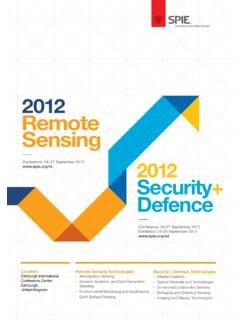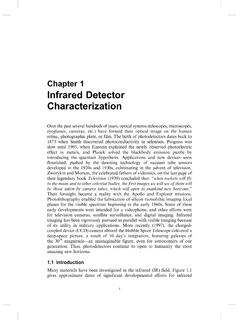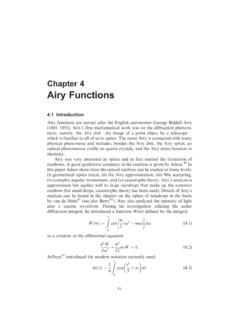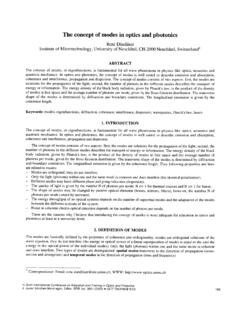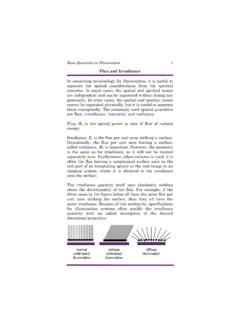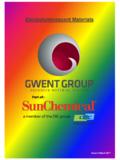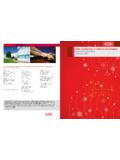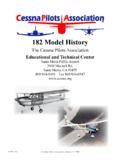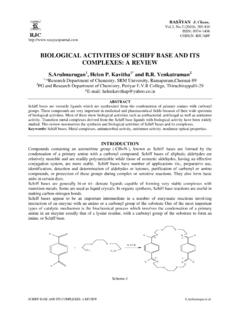Transcription of Chapter 1 Introduction to Radiometry - SPIE
1 1 Chapter 1 Introduction to Radiometry Definitions Consider the following definitions a starting point for our study of Radiometry : radio- [<L. radius] a combining form meaning ray, raylike -metry [Gr. -metria < metron] a terminal combining form meaning the process, art, or science of measuring radiometer (r 'd - m -ter) n. [radio- + -meter], an instrument for detecting and measuring the intensity of radiant energy, by exposing to sunlight a set of vanes blackened on one side and suspended on an axis in a vacuum and measuring their speed of rotation ( , the mechanical energy into which the radiant energy has been converted) (See Fig. ) Radiometry ( r 'd m tri), n. the use of the radiometer: the measurement of radiation1 These definitions are taken from Webster's New World Dictionary, and may be satisfactory for the general nonscientist.
2 The definitions are not satisfactory, however, for scientists and engineers pursuing the art of Radiometry . So let s get technical: Radiometry (r 'd m tri) n. the measurement of optical radiant energy The practical electromagnetic spectrum extends from dc to frequencies greater than 1020 Hz. The optical portion of the spectrum covers the five-decade frequency range from 3 1011 to 3 1016 Hz, corresponding to the wavelength range from 10 nm to 1000 m, as shown in Fig. This range includes the ultraviolet, visible, and infrared regions. Shorter wavelengths are called x rays and gamma rays, while longer wavelengths are microwave and millimeter radio waves.
3 2 Chapter 1 Figure Classic vane radiometer, commonly called the Crooke [Reprinted by permission from Webster s Third New International Dictionary, Unabridged 1993 by Merriam-Webster, Incorporated ( )]. The optical radiation spectrum will be treated in this text, including the ultraviolet, visible, and infrared regions. The visible portion of the optical spectrum covers a rather narrow band of wavelengths between 380 nm and 760 nm; the radiation between these limits, perceivable by the unaided normal human eye, is termed light. Measurements within this region may be called photometric if the instruments used incorporate the response of the eye. The short wavelength (ultraviolet) limit of radiometric coverage is about 200 nm, approximately the shortest wavelength that our atmosphere will transmit.
4 The longest wavelength (infrared) treated in this book is about 100 m. This wavelength range includes 99% of the energy (95% of the photons) from a thermal radiator at 0 C ( K). Why Measure Light? But why measure light in the visible, ultraviolet, or even infrared region? What are these measurements good for? Let's look at some historical perspectives: I often say that when you can measure what you are speaking about, and express it in numbers, you know something about it; but when you cannot measure it, when you cannot express it in numbers, your knowledge is of a meager and unsatisfactory kind; it may be the beginning of knowledge, but you have scarcely, in your thoughts, advanced to the stage of science, whatever the matter may be.
5 Lord Kelvin Introduction to Radiometry 3 Figure The electromagnetic [Reprinted by permission of author from Optical Radiation Measurement series, Vol. 1, F. Grum and R. J. Becherer, Radiometry , p. 1 (1979)]. 4 Chapter 1 ..nobody will object to an ardent experimentalist boasting of his measurements and rather looking down on the paper and ink physics of his theoretical friend, who on his own part is proud of his lofty ideas and despises the dirty fingers of the other. Max Born If you are really doing optics, you get photons under your fingernails. James M. Palmer Measurement is the point at which the rubber meets the road. Hypotheses, uncorroborated by measurement, cannot fulfill the same function.
6 And if rubber doesn t meet the road, the car cannot move. The measurement of light is often critical in transitioning from theory to the development of systems and techniques. Although instrument and system design may be based on theory, performance evaluation and system improvement require that accurate radiometric measurements be applied. When calibrated measurements are needed, that is, when field or laboratory measurements must be correlated with specific values presenting the relationship between measured phenomena and an absolute standard, radiometric measurements take on even greater significance. Historical Background Scientists and engineers have been involved in the measurement of light since the early experiments and instruments described by P.
7 Bouguer in 1729 and by J. H. Lambert in 1760. Exploration into other spectral regions began with the discovery of the infrared region by W. Herschel in 1800 and the ultraviolet region by J. W. Ritter the following year. Table shows some of the significant events in the history of Radiometry and photometry. Table Some significant events in Radiometry . Year Event Principal investigator ? .. and then there was light! from Genesis 1666 Investigation of the visible spectrum Newton 1729 Inverse square law Bouguer 1760 Cosine law, exponential absorption Lambert 1800 Discovery of the infrared region Herschel 1801 Discovery of the ultraviolet region Ritter 1830 Radiation thermopile (first practical detector) Nobile, Melloni 1837 Calorimetric detector Pouillet 1839 Photoelectric effect Becquerel 1859 Relation between absorption and emission Kirchhoff Introduction to Radiometry 5 Table (Continued.)
8 Year Event Principal investigator 1860 Standard lamp fueld by sperm whale oil British Metropolitan Gas Act 1879 Incandescent lamp (carbon filament) Edison 1880 Bolometer Langley 1892 Integrating sphere (theory) Sumpner 1893 Absolute thermal detector (pyrheliometer) Angstrom, Kurlbaum 1900 Blackbody radiation theory Planck 1900 Integrating sphere (reduction to practice) Ulbricht 1905 Photoelectric effect Einstein 1910 Tungsten lamp Collidge 1931 Adoption of colorimetric standards International Commission on Illumination (CIE) 1936 Photomultiplier tube (multistage) Zworykin, Morton & Malter 1938 Pyroelectric detector (theoretical) Ta 1948 Adoption of platinum blackbody for standard candela Consultative Committee on Photometry and Radiometry (CCPM) 1954 Silicon photodiode Chapin, Fuller & Pearson 1955 Pyroelectric detector (reduction to practice) Chenowyth 1960 Invention of light amplification by stimulated emission of radiation (LASER)
9 Maiman 1961 Tungsten-halogen lamp Zubler & Mosby 1970 Laser calorimetry West 1975 Fourier transform spectrometer Vanesse 1977 Photometry relegated to subset of Radiometry CCPM 1980 Self-calibrated silicon detector Zalewski & Geist 1983 Trap detector Zalewski & Duda 1984 Definitive measurement of the Stefan-Boltzmann constant Quinn & Martin 1985 Cryogenic absolute radiometer Martin, Fox, Foukal Radiometric Measurement Process This book describes the many facets of optical radiation measurement, from radiation sources to detectors and signal processing. To fully understand and appreciate a radiometric measurement, we must understand the processes of 6 Chapter 1 generation, transmission, and detection of optical radiation.
10 In addition, we must possess a firm grasp of the underlying mathematics and what is loosely called measurement science. A generic radiometric configuration is shown in Fig. A target, or object of measurement interest, can be either active, emitting radiation by virtue of its temperature or some form of atomic excitation, or passive, reflecting radiation from a different active or passive illuminator. Examples of active sources include the sun, tungsten or fluorescent lamps, lasers, and any nontransparent object with a temperature greater than 0 K. Passive sources include the entire range of natural and artificial reflective surfaces that make up our environment. An additional source of optical radiation can be classified as background, the radiation that may be in our instrumental field of view along with the target.

